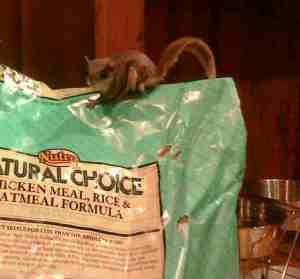When we arrived home on Friday evening my wife called to me from the kitchen, thinking she heard a dripping sound. As we listened closer, I looked up to see a flying squirrel (Glaucomys volans volans) nibbling something on a rafter above. The squirrel scrambled down a timber, went to our older dog's bowl, drank some water, then grabbed a piece of kibble and scooted upward again. Like us, until this weekend, the little squirrel was generally happier inside than outside. She was too small to be caught in a squirrel trap, so after she was convinced I was safe (eventually eating from my hand), I tricked her into feeling secure in a bag of dog food, pinched it closed, carried it outside, and reversed the process. Cute as they are, flying squirrels can do a lot of damage and have been known to carry zoonotics.
[caption id="attachment_25" align="alignnone" width="300" caption="Our house guest"]
 [/caption]
[/caption]I saw the first tadpoles in our ponds on Saturday, where the ice was mostly paper thin if present at all. There's no sign of turtles in the ponds or river yet. All the wetlands are thoroughly wet, and that makes me optimistic.
Other than ravens (Corvus corax) and crows (Corvus brachyrhynchos), the only birds I'm seeing regularly are cardinals (Cardinalis cardalinas), titmice (Baeolophus bicolor), a variety of woodpeckers, Canada geese (Branta canadensis), juncos (Junco hyemalis), and an occasional turkey (Meleagris gallopavo) and a few pairs of American mergansers (Mergus merganser americanus) on the river - all winter residents. The robins (Turdus migratorius) seem to be arriving in places in Zone 7a, so we'll start seeing more of them next week.
Sycamore seeds (Platanus occidentalis) are prominant, but otherwise not much is happening in the plants world, except that the newly exposed ground covers look plenty moist and with plenty of green understory. The native red cedars (Juniperus virginiana) seem to be doing fine, unlike many of their transplanted cousins from the same family Cupressaceae (aborvitae, Leyland cypress and others), which are sometimes bent over and uprooted by the burden of heavy snows. We've seen a few smaller white pines (Pinus strobus) that had similar troubles, where the tree tops were still pinned to the ground by snow.
The whitetail deer (Odocoileus virginianus) and cottontail rabbits ( Sylvilagus floridanus) I've seen this week still look healthy, although I've seen a few deer remains from what appeared to be younger, probably later-born fawns.
The South Branch, Cacapon and Little Cacapon rivers all seem to be rising slightly, warming significantly, and maintaining that late-winter green color, although I won't be surprised to see a brown color in all three soon.
I'm always curious to know what you're seeing. Send an email to jim@woodhouseresearch.org or better, use our online form: http://tiny.cc/hampshireoutdoors
No comments:
Post a Comment
Comments are moderated for SPAM (or trolls); otherwise all comments will be welcome.